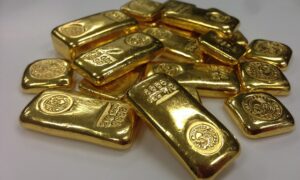As geopolitical tensions continue to rise around the world, consumers may want to consider these tensions’ potential economic effects.
U.S. Money Reserve President Philip N. Diehl, who also served as the 35th Director of the U.S. Mint, shares his thoughts on geopolitical risk — including ways physical gold can help hedge a portfolio against it — in an edition of “Market Insider,” U.S. Money Reserve’s review of current market conditions available on the company’s website and YouTube channel.
Historically, warfare is one of the factors that has helped drive gold prices — an outcome we’ve seen in the past year, Diehl says, as the issues occurring in the Middle East spread from Gaza and Israel to the West Bank, Yemen, Syria, Iraq, and eventually Lebanon and Iran.
“Other nations are now being drawn into the conflict — the U.S., our European allies, Egypt, Saudi Arabia, Jordan, and Turkey,” Diehl says. “It is no exaggeration to say [that] these are dangerous developments.”
Growing Geographic Concerns
The warfare in the Middle East isn’t the only conflict impacting gold prices, according to Diehl. Other major disputes generating gold demand include Russia’s war with Ukraine, which has also led to other nations along its western border preparing to defend themselves, and rising tensions between China and Taiwan.
“Chinese President Xi [Jinping] has ordered his military to be prepared to invade Taiwan by 2027,” Diehl says. “In the meantime, he is deepening military cooperation with Russia and Iran while ramping up conflict with nations bordering the South China Sea.”
The Chinese economy, Diehl says, is suffering and poses the risk of Xi becoming tempted to wage war to distract citizens from their financial situations.
Military conflict that occurs outside of the United States can impact numerous domestic economic elements, such as defense spending, which the U.S. government has already increased. Diehl anticipates the pace of increased defense spending will likely accelerate, which could boost the economy and create jobs — and possibly raise inflation rates.
“Western sanctions on Russia led to a sharp increase in energy prices, juicing inflation for American consumers,” Diehl says. “But sanctions also generated windfall profits and jobs for U.S. oil and gas producers, downstream operators, and liquid natural gas suppliers to Europe.”
Before the Russia-Ukraine war, Ukraine was a major agricultural product exporter. As shipments declined after the Russian invasion and U.S. and global inflation rates rose, U.S. agricultural suppliers benefited from higher prices. Similarly, Diehl says, with much of the world’s oil sourced from the Middle East, expectations of a wider war in the region contributed to oil prices increasing by more than 5%.
According to the U.S. Money Reserve President, tensions between the United States and China are now having a notable effect on our economy. The U.S. is onshoring the production of a number of manufactured and strategic commodities that were previously imported from China, which, while raising costs, is also creating American jobs and helping to protect national security.
“The impact of these conflicts is complex — except for when it comes to gold,” Diehl says. “You can look back over the last year and see the proof. When rumors of war, fears of war, or outright warfare have risen, gold follows suit.”



































